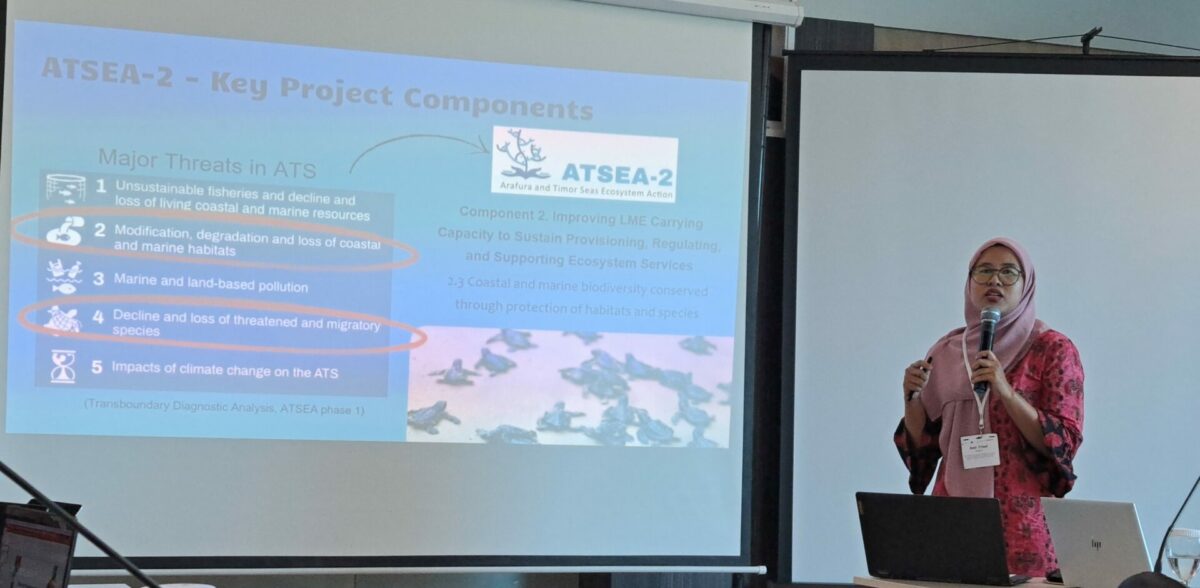From 15-17 May 2023, the ATSEA-2 Project participated in a workshop entitled “Protecting Marine Migratory Species and Achieving the 30×30 Target” in Manado, Indonesia. This three-day event, organised by the European Union Ocean Governance project and the Marine Protected Area (MPA) Working Group of the Coral Triangle Initiative on Coral Reefs, Fisheries and Food Security (CTI-CFF), set out to safeguard marine biodiversity and contribute to global conservation goals.
The workshop emphasised the importance of transboundary conservation measures in protecting migratory species and maintaining ecological balance. It addressed the movement of migratory marine mammals across national boundaries, with an emphasis on promoting transnational cooperation. Aligned with the Kunming-Montreal Global Biodiversity Framework, the workshop focused on establishing well-connected and equitable systems of protected areas to achieve effective conservation and management.

in the Arafura and Timor Seas (ATS) region
The ATSEA-2 Project, represented by Deti Triani (Marine Technical Officer), shared key insights related to the development of MPA networks in the Arafura and Timor Seas (ATS) region. She provided a profile of the region and outlined the current status of sea turtles, while also presenting the project’s regional sea turtle action plan and MPA network design proposal.
“The ATS region is home to diverse marine life,” explained Deti during her presentation. “In addition to the Coral Triangle, the region [is home to] large mangrove areas and is extremely rich in non-living natural resources, including oil and gas reserves,” she added. She also highlighted that the economic value of the ATS region is currently estimated at around US$ 7.3 billion per year.
Following a Transboundary Diagnostic Analysis (TDA) that was conducted in the first phase of the project, several major threats to the ATS region have been identified. As Deti explained during her presentation, these include unsustainable fisheries, habitat modification and degradation, pollution, the decline of threatened and migratory species, and the impacts of climate change.
To address these challenges, ATSEA-2 is focusing on implementing a Strategic Action Plan (SAP) to improve the carrying capacity of the Large Marine Ecosystem (LME), thereby helping to support ecosystem services and conserve coastal and marine biodiversity.
In regards to migratory species, sea turtles are particularly vulnerable to threats such as bycatch in fisheries, entanglement and ingestion of discarded fishing gear, along with predation, poaching and climate change. Legal infrastructure is crucial to sea turtle protection, involving national provisions and relevant international conventions and initiatives, fisheries management and management by Indigenous communities.
Deti continued by sharing information related to ATSEA-2’s Regional Sea Turtle Action Plan for the ATS, which focuses on reducing the impact of discarded fishing gear, establishing a funding mechanism, reducing sea turtle bycatch in Arafura Sea prawn fisheries (Indonesia) and enhancing sea turtle conservation along the southern coast of Timor-Leste, the Aru Archipelago and Papua New Guinea.
“I think we all agree the best way to protect sea turtles is by making a network of MPAs,” explained Deti, before revealing that the ATSEA-2 Project has already designed an MPA network for the ATS region, comprising 93 existing and proposed MPAs and covering a total area of 271,406 km2. “Additionally, there are 18 Areas of Interest (AOI) totaling 29,467 km2, including contributions from the previous and post-design phases – if all these AOI are followed up as a single MPA or OECM, it could expand protected areas in ATS region by an additional 10 percent,” Deti added.
To support this process of expansion, ATSEA-2 has been influential in the establishment of two new MPAs, located in Kolepom Island, South Papua and Manufahi Municipality, Timor-Leste. Moreover, support for existing MPAs, such as Nino Konis Santana in Timor-Leste and Southeast Aru MPA in Maluku, has been provided, particularly in regard to improvements in management effectiveness, updates to management plans and the development of a financial sustainability plan.
The Project’s MPA network and Regional Action Plan for sea turtles could not have been developed without continuous support from the ATSEA-2 Regional Steering Committee during an ongoing process of national and regional consultation. In addition, collaborators such as CTC, YKAN, Dr Nicolas Pilcher from Marine Research Foundation and other experts such as Dr Alison Green and Dr Kiki Dethmers, have each played their part in the analysis and refinement process, while a data sharing agreement with WWF-Indonesia has been invaluable to conservation efforts.
Work completed thus far by the ATSEA-2 Project and its network of partners, combined with lessons learned from interventions in the ATS region, underscore the importance of international cooperation and effective conservation strategies in protecting migratory species and preserving marine ecosystems. Looking to the future, these collaborative networks will be key to achieving the 30×30 target, thereby helping to protect species in the ATS region and beyond.
By Stella Yovita Arya Puteri & Deti Triani


